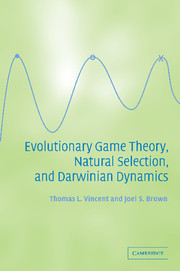Book contents
- Frontmatter
- Contents
- List of figures
- Preface
- 1 Understanding natural selection
- 2 Underlying mathematics and philosophy
- 3 The Darwinian game
- 4 G-functions for the Darwinian game
- 5 Darwinian dynamics
- 6 Evolutionarily stable strategies
- 7 The ESS maximum principle
- 8 Speciation and extinction
- 9 Matrix games
- 10 Evolutionary ecology
- 11 Managing evolving systems
- References
- Index
4 - G-functions for the Darwinian game
Published online by Cambridge University Press: 11 August 2009
- Frontmatter
- Contents
- List of figures
- Preface
- 1 Understanding natural selection
- 2 Underlying mathematics and philosophy
- 3 The Darwinian game
- 4 G-functions for the Darwinian game
- 5 Darwinian dynamics
- 6 Evolutionarily stable strategies
- 7 The ESS maximum principle
- 8 Speciation and extinction
- 9 Matrix games
- 10 Evolutionary ecology
- 11 Managing evolving systems
- References
- Index
Summary
A bauplan for a group of evolutionarily identical individuals together with their environment represents the essential elements needed to construct a G-function. The bauplan has two aspects. First, it describes a set of evolutionarily feasible strategies, and, second, it specifies the intrinsic ecological properties, aptitudes, trade-offs, and limitations of this group. The environment provides a setting within which the bauplan produces species that evolve, diversify, and persist. For instance, hornbills, a frugivorous bird of African forests, differ in size, wing morphology, and bill characteristics. However, all members of the group are easily identifiable as hornbills quite distinct from other birds. It is reasonable to assume that all species of hornbills share the same bauplan and, hence, within the same environment their fitness is determined from a single G-function. Toucans of Central and South America occupy similar ecological niches to hornbills. These birds have radiated along similar morphological lines to hornbills. Yet they have a distinct bauplan from hornbills and from other bird groups. In an evolutionary game involving both hornbills and toucans, two G-functions would be required.
When modeling evolution, one usually has some taxa (such as hornbills or toucans) along with an environmental setting in mind. In this chapter, we undertake the practical task of bringing together the mathematical notation of Chapter 2 and the G-function, Definition 3.2.1, to formulate the required fitness generating functions. We will consider a number of different evolutionary games.
Information
- Type
- Chapter
- Information
- Publisher: Cambridge University PressPrint publication year: 2005
